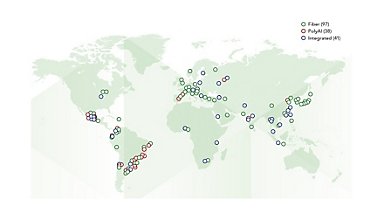When want to be deliberate about choosing an environmentally friendly bottled water, it’s important to consider the types of materials that it comes in. Within the options that are available to us, carton containers like Tetra Paks® have become a topic of discussion. A variety of beverages, from milk to juice and water products, are offered in carton containers. This article aims to provide an objective and comprehensive view of carton packaging, examining its production, recycling processes, and environmental impact.
Are Tetra Paks® recyclable?
Tetra Paks® are designed to be recyclable and can be processed into new materials, primarily paper products. However, the recycling of Tetra Paks® depends significantly on local infrastructure capabilities and whether facilities exist. Of the 193 billion cartons manufactured in 2022 globally, only ¼ were actually recycled, despite labels on the packages declaring it “recyclable.” The big reason for that is Tetra Paks® have a specialized recycling process. Countries in the European Union have a high rate of Tetra Pal usage and a high rate of facilities that will process them for recycling. Tetra Paks® are sold around the world, however, so it’s essential to verify whether your local recycling facilities accept these containers. The availability of recycling options vary by region and where specialized facilities exist.
To better understand your area's recycling capabilities, you can refer to local waste management resources like earth911.org or online maps that highlight carton recycling points. These resources can provide you with a clearer picture of the feasibility of recycling Tetra Paks® in your locality, enabling you to make informed decisions about your waste disposal.
Are all materials in a Tetra Pak recycled?
Recycling Tetra Paks® involves separating their various components, which include 14% plastic sheets, 6% bioplastic caps, 75% cardboard, and 5% aluminum. Of these, the cardboard element, which constitutes the majority, is the primary material recycled, often being processed into new paper products. However, the recycling process faces challenges with the other components. The plastic and aluminum, once combined into a material known as poly-aluminum, are more difficult to recycle in their current form. This mix typically undergoes downcycling, transforming into products like car floor mats, plastic pens, and decking, which are not always further recyclable. Therefore, while parts of Tetra Paks® can be recycled, the process does not fully reincorporate all materials into the recycling loop, highlighting areas for potential improvement in packaging design and recycling technologies.

Here are 10 facts to consider when exploring how Tetra Paks® packaging stacks up.
#1 Single-Use
Tetra Paks® are predominantly single-use. Even though some contain a spout with a lid, the intended use is singular, which poses challenges for sustainability efforts. While they utilize renewable resources, the push towards a less wasteful society emphasizes the need for packaging that can be reused, reducing reliance on single-use solutions.
#2 Recycling Rate
Tetra Paks® has a recycling rate of 26% globally, which, while better than some plastics, is lower compared to materials like aluminum. This statistic underlines the importance of assessing and improving recycling systems to enhance sustainability.
#3 Recycling Facility Availability
The recyclability of Tetra Paks® depends on local infrastructure. In areas where facilities are available, Tetra Paks® can be processed effectively. However, these containers face recycling challenges in places lacking these facilities, highlighting the need for accessible and widespread recycling solutions.

Source: Tetra Paks®
#4 Downcycling
The recycling process for Tetra Paks® often leads to downcycling, where materials are repurposed into lower-value products. While this extends the use of materials, it does not fully reincorporate them into the recycling loop, indicating a potential area for improvement in recycling technology.
#5 Closed-Loop Recycling
Tetra Paks® does not currently operate within a closed-loop recycling system, where materials are repeatedly reused in the same form. This contrasts with materials like aluminum, which can be recycled back into similar products, suggesting a goal to work on for packaging sustainability.
#6 Use of Virgin Materials
The production of Tetra Paks® often requires new, unrecycled materials. Any single-use container reliant on virgin materials brings concern about the sustainability of resources used in packaging production. In particular, 14% of the plastic used in the packaging is virgin, and plastic is most often a linear waste stream.
#7 Use of Agricultural Products
The use of agricultural products for packaging, such as in Tetra Paks®, merits consideration regarding environmental impacts. While undoubtedly, trees and fibers are renewable source materials, meaning they can be planted and replenished, given the state of our climate emergency, considerations can be made about the overall cost benefits of using virgin fibers for single-use containers. Tetra Pak does source materials certified by the Forest Stewardship Council, which may help lessen the effects.
#8 Long-Term Reusability
Although Tetra Paks® are marketed as reusable to a certain extent, their design and material composition do not inherently support long-term reuse. The emphasis on developing packaging designed for extended use is important for reducing waste and promoting sustainability. From a question posed in a Quora thread on the topic of carton reuse, we can see if consumers consider these containers reusable or disposable.
#9 Closed Loop Capabilities
Wherever beverage container materials can be put into a reliable recycling system that is easily repeatable and widespread globally, these are the most ideal containers for operating closed loop on materiality. An example of an excellent closed-loop system is aluminum. About 75% of all aluminum that was ever put into production is still in use and cycling through the recycling process to this day. This means that as long as aluminum makes it to a recycling facility, 100% of it can be recovered and recycled into new products, over and over again, infinitely. And because of the high value of aluminum, this happens 76% of the time.
#10 Complexity of Materials
Tetra Paks® comprises several materials, complicating a recycling process that would ideally turn materials back into their first-use type. This complexity can affect the ability to recycle these components into new, high-value products, underscoring the need for packaging designs that facilitate easier recycling. In one study, these complex mixed materials were held together and used as polyaminiate boards. So they were recycled; however, they were not separated and recycled as individual materials.
While these products have been marketed as sustainable solutions, it's important to consider the broader environmental perspective, which suggests that the shift toward sustainability may be gradual rather than immediate.
As society addresses the challenges of plastic waste, legislative actions like the Plastic Pollution Prevention and Packaging Producer Responsibility Act (SB 54), signed by California Governor Newson, reflect a growing commitment to reducing and eliminating single-use plastics. Yet, the timeline for these changes highlights the urgency of finding more immediate, sustainable solutions. While Tetra Paks® represents a step away from traditional single-use plastics, the ultimate goal is to foster a culture of reuse, emphasizing the need for systems that support the repeated use of materials and products.
Transitioning to a reuse-focused approach requires a collective shift in how we view and manage packaging. It involves choosing reusable options over single-use alternatives and critically evaluating and supporting solutions that offer genuine long-term sustainability.
By embracing reusable packaging and fostering a #RefillNotLandfill culture, we are creating a pivotal solution to the environmental challenges of single-use bottled water.
Resources
https://www.sciencedirect.com/science/article/abs/pii/S0921344920305838
https://www.sciencedirect.com/science/article/abs/pii/S095965261930873X
https://www.ellenmacarthurfoundation.org/plastics-and-the-circular-economy-deep-dive
https://treadingmyownpath.com/2014/09/11/why-tetra-paks-arent-green-even-though-theyre-recyclable/
https://www.tetrapak.com/sustainability/recycling
https://www.planetaid.org/blog/recycling-rates-around-the-world
https://www.aluminiumtoday.com/news/view/alu-recycling-rate
https://tpcomprod2.blob.core.windows.net/static/documents/our-role-protecting-forests.pdf








